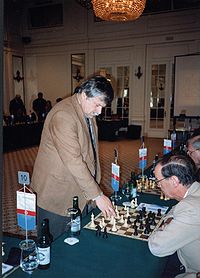
- Chess World Cup
- FIDE Grand Prix
- Olympiad
- World Championship
- List of strong tournaments
- List of world championships

- Checkmate patterns
- Chess openings
- Chess strategy
- Chess tactics
- Chess theory
- Endgames
- Pawn structure
- Problems/Compositions












 Grandmaster Vlastimil Hort giving a simultaneous exhibition, 1997
Grandmaster Vlastimil Hort giving a simultaneous exhibition, 1997A simultaneous exhibition or simultaneous display is a board game exhibition (commonly chess or Go) in which one player (typically of high rank, such as a grandmaster or dan-level player) plays multiple games at a time with a number of other players. Such an exhibition is often referred to simply as a "simul."
In a regular simul, no chess clocks are used (if they are involved it is called a clock simul). The boards are usually arranged in a large circle or square and the exhibitor walks from board to board in a fixed order. Each individual participant is expected to make a move when the exhibitor arrives at his/her board. The exhibitor may pause briefly before playing his/her move, but will typically attempt to avoid lengthy pauses because too many such pauses will cause the exhibition to continue for an extended period. Longer exhibitions increase the risk of fatigue-induced blunders on the part of the exhibitor, especially since the individual participants remaining at the end tend to be the stronger players who represent the exhibitor's most challenging opponents. As games are finished off, they are usually not replaced and only a few games will remain in progress at the end of the exhibition. At this point clocks are sometimes introduced with each side getting a fixed amount of time. In most regular simuls, the exhibitor plays White in all the games and the individual participants are of varying playing strengths (though they are typically below master class).
In clock simuls all the games are played as normal tournament games and are timed by a chess clock. These simuls require the exhibitor to accept a substantial time handicap since his/her clock continues to run on all boards. These simuls typically involve a relatively small number of individual participants whose playing strength is at or near master class. Occasionally, grandmasters have given blindfold simultaneous displays. In such displays, the exhibitor does not look at any of the boards, but retains all the moves of the games in his/her head. The opponents utilize boards and pieces in the standard fashion, but their moves are communicated verbally to the exhibitor by an arbiter or intermediary.
Dutch Grandmaster Jan Hein Donner offered the following advice to a player taking a board at a simultaneous exhibition.
If you are to stand a chance of scoring a half or a full point, there are a few things to bear in mind:
- Be sure to take special care in the opening. Play something you know well and play carefully. The simul-giver will be very unpleasantly surprised to find that after some twenty moves he has achieved nothing at your board. He will usually propose a draw to be rid of such a troublemaker. Do not accept! Your boldness will greatly upset him.
- Play aggressively. Ninety-five percent of all victims in simultaneous displays usually owe their defeat to their own passivity. The simul-giver lacks the time to work out variations but doing so is more important when defending than in an attack. On psychological grounds, too, aggressively approaching the simul-giver is a sound and very effective strategy.
- Don't be afraid to exchange pieces. The simul-giver will play the endgame much better than you, of course, but it is - once again - very important at this stage of the game to calculate variations and that is precisely what he has no time for. Do not be afraid!
Here are some significant games from simultaneous exhibitions:
A less popular variation of Simultaneous exhibition is the tandem simultaneous exhibition, also known as leapfrog simultaneous exhibition, where more than one (usually two) experts play a number of opponents, making successive moves without consulting one another.